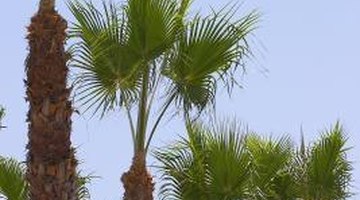While people colloquially refer to them as palm trees, palms are not true trees in their morphology and growth. Pruning an apple, oak or pine tree results in dormant buds on the branches sprouting. This doesn't occur on palms. Removing the top of a palm kills it, as no new leaf bud forms. Decapitating a palm creates a barren, polelike stem or trunk that slowly rots away.
Palm Types

Landscape maintenance crews and arborists often proactively prune palms removing old, clinging dead fronds to improve the appearance of palms. Cabbage, date, California and Mexican fan palms retain their dead fronds in a petticoat over the trunk. While cutting away dead fronds is a sound horticultural practice, removing green or yellowing fronds is not. Removing fronds that photosynthesise light slows the palm's growth and vitality. Removing too many fronds exposes the lone bud in the growing tip or crownshaft. Exposed growing tips are susceptible to windstorm damage. Bruising, snapping or cracking of the growing tip also results in the bud dying, a situation similar to decapitation.
- Landscape maintenance crews and arborists often proactively prune palms removing old, clinging dead fronds to improve the appearance of palms.
- Removing fronds that photosynthesise light slows the palm's growth and vitality.
Growing Tip
Palms only grow from the bud in the tip of the trunks or stems. This area is referred to as the growing tip or the crownshaft if a plump, elongated green column sits atop the grey trunk top. New fronds emerge from the growing tip or crownshaft. Cutting off the top of any palm's stem or trunk removing the growing point, ends that trunk or stem's growth. No new growing tip develops on palm stems or trunks. A solitary palm dies if decapitated, but a clustering palm usually rejuvenates with replacement lower basal sprouts from the roots.
- Palms only grow from the bud in the tip of the trunks or stems.
- A solitary palm dies if decapitated, but a clustering palm usually rejuvenates with replacement lower basal sprouts from the roots.
Canopy Pruning

Landscape maintenance crews and arborists often proactively prune palms to remove old, clinging dead fronds to improve the appearance of palms. Cabbage, date, California and Mexican fan palms tend to retain their dead fronds in a petticoat over the trunk. While cutting away dead fronds is a sound horticultural practice, removing green or yellowing fronds is not. Removing fronds that photosynthesis light slows the palm's growth and vitality. Removing too many fronds exposes the lone bud in the growing tip or crownshaft. Exposed growing tips are more susceptible to windstorm damage. Bruising, snapping or cracking of the growing tip can also result in the bud dying, resulting in a situation similar to decapitating a palm.
- Landscape maintenance crews and arborists often proactively prune palms to remove old, clinging dead fronds to improve the appearance of palms.
- Cabbage, date, California and Mexican fan palms tend to retain their dead fronds in a petticoat over the trunk.
Appropriate Applications
Cut off the top of a palm only when the goal is to kill or remove the palm from the landscape. Decapitating a palm is akin to cutting its trunk or stem off flush with the ground. On very large or tall palms, workers may cut off the palm in trunk sections to better control the palm's removal, especially in crowded urban areas. Decapitated palms warrant full removal, as the remaining trunks will rot and often now reveal any hints of instability. Dead palm trunks can tip over, crushing both bystanders and property.
- Cut off the top of a palm only when the goal is to kill or remove the palm from the landscape.
- On very large or tall palms, workers may cut off the palm in trunk sections to better control the palm's removal, especially in crowded urban areas.
